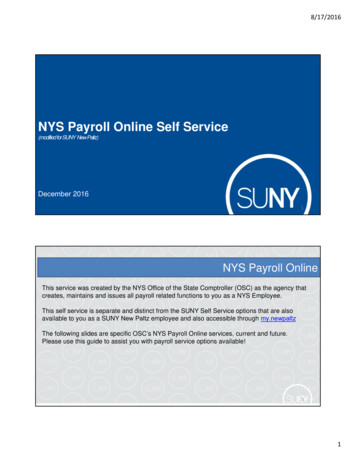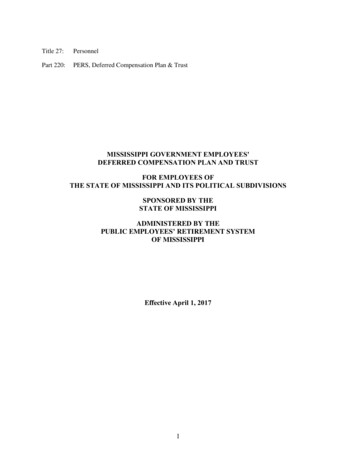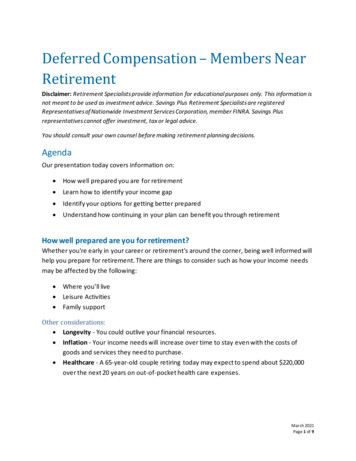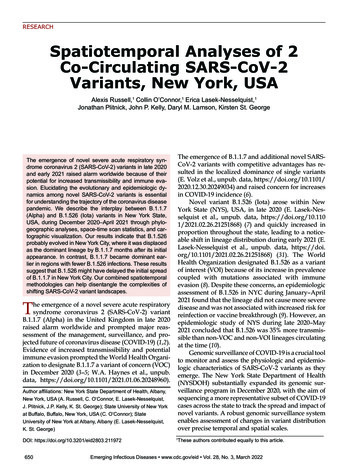
Transcription
Chapter 8NYS DeferredCompensation Planwww.nysdcp.comWe gratefully acknowledge the cooperation of the New York State DeferredCompensation Plan who provided the information contained in this chapter, andwho are entirely responsible for its contents.1.2022Self-Help Guide 8-1
OverviewThe Deferred Compensation Plan (the Plan) is a voluntary retirement savings program, createdby Federal and state law, enabling public employees to defer a portion of their gross pay. Thefollowing provides an overview of the Plan. For greater detail on the Plan and its benefits, visit thePlan Website at www.nysdcp.com or call the Plan HELPLINE at 1-800-422-8463.WHAT DOES DEFERRED COMPENSATION MEAN TO ME?It means that you may defer a portion of your salary on a pre-tax, or after-tax basis. The amount ofyour salary that you defer pre-tax to the Plan is not subject to current Federal or New York Stateincome taxes. The result is that the amount that you are investing for your retirement is greater than thereduction in your take-home-pay. Pre-tax deferrals reduce your taxable income and, therefore, loweryour Federal or New York State income taxes. You, therefore, are building greater retirement savingsfor your future. The amount you contribute to a Roth account comes out of your paycheck after NewYork State and Federal taxes. Roth contributions may be eligible for tax-free withdrawals.Suppose you earn 1,500 per pay period. And, let us assume you would like to put 100per pay period to the Plan. Instead of withholding taxes based on 1,500, your employer wouldcalculate your income tax withholding based on 1,400 because your 100 is not subject tocurrent Federal or New York State income tax withholding. Thus, at the end of the year, yourIRS Form W-2 will reflect 36,400 of taxable wages instead of 39,000.Sample 2022 Paycheck al Withholding AllowanceS-1S-1State Withholding AllowanceS-1S-1Gross Salary 1,500.00 1,500.00Plan Deferrals 0.00 100.00Taxable Salary 1,500.00 1,400.00Social Security 115.00 115.00Federal Income Tax 184.00 161.00NY State Income Tax 66.00 60.00Regular Savings 100.00 0.00Take Home Pay 1035.00 1064.00Paycheck breakdownMaximumParticipationS-1S-1 1,500.00 788.46* 711.54 115.00 71.15 6.00 0.00 518.85(Please note, salary deferrals to the Plan are not exempt from income taxes in some states. If youare not a New York State resident, please check the income tax status of deferred compensationdeferrals in your state.)* Based on the 2022 contribution limit of 20,500 spread over 26 pay periods.Self-Help Guide 8-2
SAVING MORE USING DEFERRED COMPENSATION (PRE-TAX)(*Note: assumes person filing as single with one withholding allowance,total includes Federal, State and Social Security Taxes)Gross SalaryDef. Comp.TaxableTakeWithholding*SavingsIncomeHome 1,500 138 1,362 327 1,035Another way of looking at this is that you can take home the same 1,035 you would have bysaving with after-tax dollars and save 38 more per pay period ( 138 vs. 100) by saving with pretax dollars through deferrals to the Plan.If you are a Tier 3 or Tier 4 member with less than 10 years of service, contributions to thePlan will be calculated after your contribution to the Retirement System. In addition, if your healthcontributions are taken on a before-tax basis, your Plan contributions will be based on theremaining salary.For most people, deferred compensation is a good way to use your income earning years as adirect means to supplement your pension and Social Security benefits when you retire and builda bright financial future. Later in this chapter we’ll discuss how to know if the Plan is right foryou.Let’s look at how much could be accumulated in your Plan Account if you participated in aninvestment option under the Plan that earns a seven percent annual return.Year5101525Cash Value Accumulation ChartIllustration of Accumulation Based onContribution Amount 75 per pay 100 per pay 150 per payperiod orperiod orperiod or 1,950/year 2,600/year 3,900/year 11,617 15,489 23,234 27,911 37,214 55,821 50,763 67,684 101,527 127,770 170,360 255,540Based on 7% annual return.This is not a guarantee or indication of future investment returnsunder any investment option available under the Plan.Each Plan distribution is taxable as ordinary income when youreceive it.Self-Help Guide 8-3
COMMONLY ASKED QUESTIONSDoes this mean that income taxes will never have to be paid on my Plan contributions?No. Qualified distribution from the Roth portion of your account can be tax-free. Whenwithdrawn, the entire pre-tax withdrawal, (including earnings) will be subject to Federal, New YorkState and local income taxes. If you reside outside of New York State distributions will be subject tothe income tax laws of your state of residence.How does contributing to the Plan affect my income taxes?Your taxable income is reduced by the amount you defer, except for Roth contributions. Forexample, if your salary is 39,000 and you defer 2,000, your income for income tax purposes willbe 37,000 on your IRS Form W-2.What other benefits are there besides income tax reductions?Building a supplemental retirement savings means that you will have greater financialindependence and you won’t have to rely only on Social Security and your pension forretirement income.Am I still eligible for an Individual Retirement Account (IRA deduction)?Participation in the Plan does not affect your eligibility for an IRA deduction.However, if either you or your spouse are an active participant in a tax qualified retirement plan,including the New York State and Local Employees’ Retirement System, you are eligible for a full IRAdeduction only if your adjusted gross income is less than an amount described in Federal law.Does contributing to the Deferred Compensation Plan affect my eligibility for a Roth IRA?No. Participation in the Plan does not affect your eligibility for a Roth IRA because contributionsto a Roth IRA are not deductible for Federal income tax purposes.How is the Deferred Compensation Plan different from an IRA?The Plan differs from an IRA in a variety of ways. It offers you the convenience of setting someretirement savings aside a little bit at a time through payroll deductions. This may help you keep thediscipline you need to save for your retirement.In addition, the Plan allows you to defer larger amounts than you can contribute to an IRA (up to100 percent of your includible compensation or 20,500 for 2022, whichever is less). Your eligibility tomake before-tax salary deferrals to the Plan are not limited by any income test like that imposed ondeductible contributions to an IRA.There are no penalties if you leave employment before age 59 1/2 and receive a distribution fromthe Plan. Once you have a severance from employment and the Plan receives a termination ofemployment notice, you will be permitted to take a distribution as long as a balance of 500 remainsin the account for 45 days after severance from employment. If you wish, you may leave the balanceof your Plan account to continue to grow even after you have left employment, up to age 72 whenthe law requires you to begin receiving Required Minimum Distributions.Self-Help Guide 8-4
Lastly, the Plan provides you a convenient place to consolidate retirement assets that you mayhave in a 401(k) or 403(b) plan, an IRA, or another governmental deferred compensation plan. The Planaccepts direct rollovers from eligible retirement plans. If you want, you have the option to roll overyour Plan assets to another governmental deferred compensation plan, 401(k) or 403(b) plan or anIndividual Retirement Account (IRA). The tax consequences, distribution options, investment options,and participation costs in each may differ from the Plan. You are encouraged to examine therequirements and limitations of any plan to which you may contemplate rolling over your Plan assets.Do deferrals affect my Social Security taxes or pension contributi
have in a 401(k) or 403(b) plan, an IRA, or another governmental deferred compensation plan. The Plan accepts direct rollovers from eligible retirement plans. If you want, you have the option to roll over your Plan assets to another governmental deferred compensation plan, 401(k) or 403(b) plan or an Individual Retirement Account (IRA).










